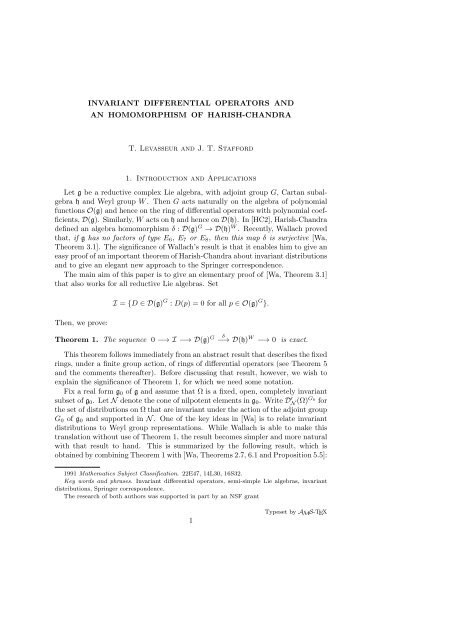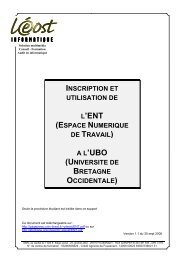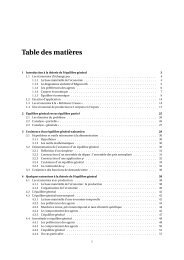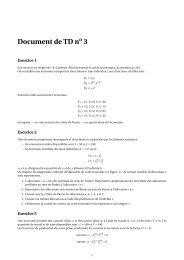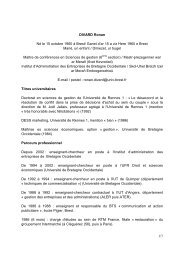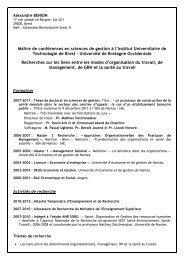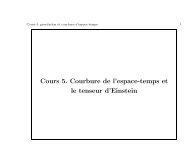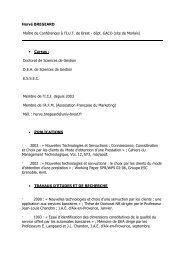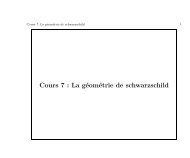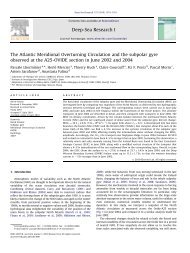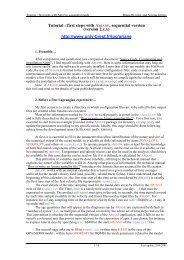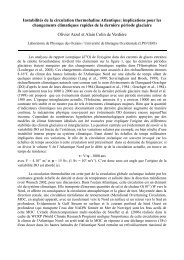INVARIANT DIFFERENTIAL OPERATORS AND AN ...
INVARIANT DIFFERENTIAL OPERATORS AND AN ...
INVARIANT DIFFERENTIAL OPERATORS AND AN ...
Create successful ePaper yourself
Turn your PDF publications into a flip-book with our unique Google optimized e-Paper software.
<strong>INVARI<strong>AN</strong>T</strong> <strong>DIFFERENTIAL</strong> <strong>OPERATORS</strong> <strong><strong>AN</strong>D</strong><strong>AN</strong> HOMOMORPHISM OF HARISH-CH<strong><strong>AN</strong>D</strong>RAT. Levasseur and J. T. Stafford1. Introduction and ApplicationsLet g be a reductive complex Lie algebra, with adjoint group G, Cartan subalgebrah and Weyl group W. Then G acts naturally on the algebra of polynomialfunctions O(g) and hence on the ring of differential operators with polynomial coefficients,D(g). Similarly, W acts on h and hence on D(h). In[HC2], Harish-Chandradefined an algebra homomorphism δ : D(g) G → D(h) W . Recently, Wallach provedthat, if g has no factors of type E 6 , E 7 or E 8 , then this map δ is surjective [Wa,Theorem 3.1]. The significance of Wallach’s result is that it enables him to give aneasyproofofanimportanttheoremofHarish-Chandraaboutinvariantdistributionsand to give an elegant new approach to the Springer correspondence.The main aim of this paper is to give an elementary proof of [Wa, Theorem 3.1]that also works for all reductive Lie algebras. SetThen, we prove:I = {D ∈ D(g) G : D(p) = 0 for all p ∈ O(g) G }.Theorem 1. The sequence 0 −→ I −→ D(g) G δ−→ D(h) W −→ 0 is exact.Thistheoremfollowsimmediatelyfromanabstractresultthatdescribesthefixedrings, under a finite group action, of rings of differential operators (see Theorem 5and the comments thereafter). Before discussing that result, however, we wish toexplain the significance of Theorem 1, for which we need some notation.Fix a real form g 0 of g and assume that Ω is a fixed, open, completely invariantsubset of g 0 . Let N denote the cone of nilpotent elements in g 0 . Write D ′ N (Ω)G0 forthe set of distributions on Ω that are invariant under the action of the adjoint groupG 0 of g 0 and supported in N. One of the key ideas in [Wa] is to relate invariantdistributions to Weyl group representations. While Wallach is able to make thistranslation without use of Theorem 1, the result becomes simpler and more naturalwith that result to hand. This is summarized by the following result, which isobtainedbycombiningTheorem1with[Wa,Theorems2.7,6.1andProposition5.5]:1991 Mathematics Subject Classification. 22E47, 14L30, 16S32.Key words and phrases. Invariant differential operators, semi-simple Lie algebras, invariantdistributions, Springer correspondence.The research of both authors was supported in part by an NSF grant1Typeset by AMS-TEX
2 T. LEVASSEUR <strong><strong>AN</strong>D</strong> J. T. STAFFORDTheorem 2. Assume that g 0 is semisimple and let T ∈ D N ′ . Then, D(g) G T (Ω)G0is killed by I. Thus, by Theorem 1 we may regard D(g) G T as a module over D(h) W .As such, D(g) G T ∈ C W ′ , the category of all finitely generated D(h)W -modules onwhich S(h ∗ ) W + acts locally nilpotently. Moreover, C W ′ is equivalent to the category offinite dimensional representations of W. Under this equivalence, D N ′ (g 0) G0 becomesa finite W-module.By taking T to be the orbital integral corresponding to a nilpotent element Xof a semisimple Lie algebra g, Wallach associates, in much this way, an irreduciblerepresentation of W to the G-orbit of X (see [Wa, Theorem 6.9]). This leads tohis construction of the Springer correspondence. Wallach’s proof can be furthersimplified since, by Theorem 1 and [Wa, Corollary 1.4], the categories C W and ČWof [Wa, Section 2] are equal. Thus, [Wa, Theorem 2.4] and [Wa, Theorem 2.6] arenow trivial consequences of [Wa, Theorem 1.4], respectively [Wa, Theorem 1.6],while [Wa, Lemma 2.5] is vacuously true.In [Wa], Wallach also gives a relatively easy proof of a fundamental result ofHarish-Chandra. Using Theorem 1, one can further simplify his argument. Indeed,by combining Theorem 1 with the first two paragraphs of the proof of [Wa,Theorem 5.4] one obtains an easy proof of the following result:Theorem 3. (see [HC3, Theorem 5]) I = {D ∈ D(g) G : DD ′ (Ω) G0 = 0}.Moreover, the argument given at the end of [Wa, Section 5] shows that this, inturn, easily implies a second result from [HC3]:Theorem 4. Let g ′ denote the set of all generic elements of g. Suppose thatT ∈ D ′ (Ω) G0 satisfies dimS(g) G T < ∞ and T ∣ = 0. Then T = 0.Ω∩g ′We end the introduction by discussing the proof of Theorem 1. This is basedon a structure theorem for rings of differential operators fixed by an arbitraryfinite group, that is of independent interest. Let V be an l-dimensional vectorspace over a field k of characteristic zero and W ⊂ GL(V) a finite group. LetO(V) ∼ = k[x 1 ,...,x l ] denote the ring of polynomial functions on V and writeD(V) = {∑ f i (∂/∂x 1 ) i1 ···(∂/∂x l ) i l: f i ∈ O(V) } for the ring of k-linear differentialoperators on O(V). We may identify the symmetric algebra S(V ∗ ) withO(V) and the algebra S(V) with the ring of constant coefficient differential operatorson V. This provides a natural identification of left S(V ∗ )-modules: D(V) =S(V ∗ ) ⊗ k S(V) (see, for example, [HC2, Section 3, Corollary 4]). The diagonalaction of W on S(V ∗ )⊗ k S(V) now identifies with the usual action of W on D(V)given by g(θ)(f) = g · (θ(g −1 · f)), for g ∈ W, θ ∈ D(V) and f ∈ O(V) (see, forexample, [HC2, pp.234-5]).Now consider D(V) W . Two obvious subspaces are the W-invariant polynomialfunctions, O(V) W = S(V ∗ ) W , and the W-invariant, constant coefficient differentialoperators, S(V) W . Remarkably, these suffice to generate D(V) W :Theorem 5. Let B be the k-subalgebra of D(V) generated by S(V ∗ ) W and S(V) W .Then, B = D(V) W .If W is a Weyl group with no factors of type E 6 , E 7 or E 8 , then this theorem isproved in [Wa], by means of a case by case analysis. The relevance of Theorem 5is that, as is shown in [Wa], it has Theorem 1 as an immediate corollary. Theargument is as follows:
<strong>INVARI<strong>AN</strong>T</strong> <strong>DIFFERENTIAL</strong> <strong>OPERATORS</strong> 3Proof of Theorem 1 from Theorem 5. Inside D(g) G one has the natural subringsS(g ∗ ) G and S(g) G . Let A be the subalgebra C〈S(g ∗ ) G , S(g) G 〉 that they generate.Then the restriction of Harish-Chandra’s homomorphism δ to S(g) G is just theChevalley isomorphism S(g) G −→S(h) ∼ W . Similarly, the restriction of δ to S(g ∗ ) Gis the Chevalley isomorphism S(g ∗ ) G −→S(h ∼ ∗ ) W (see [HC1, Theorem 1]). Thus,with V = h and W the Weyl group, Theorem 5 implies that δ maps A surjectivelyonto B = C〈S(h ∗ ) W , S(h) W 〉 = D(h) W . Since I = Ker(δ) (see [HC2, Theorem 1])this completes the proof of Theorem 1, modulo proving Theorem 5. Note that thisargument also shows that D(g) G = A+I.□2. The Proof of Theorem FiveWe will continue to use the identifications described in the introduction; inparticular we will always make the identification S(V ∗ ) ⊗ k S(V) = D(V). LetS(V) = ⊕ i≥0 Si (V) be the usual graded structure of S(V) and write {S(V) n =⊕i≤n Si (V)} for the corresponding filtration of S(V). This induces a filtered structureD(V) = ⋃ D(V) n on D(V) by defining D(V) n = S(V ∗ ) ⊗ k S(V) n . SinceS(V) has been identified with the constant coefficient differential operators, thisfiltration is nothing more than the filtration of D(V) by degree of differential operatorsand so, in particular, is a filtration of D(V) as a k-algebra. Given anysubalgebra, or even subspace, R ⊆ D(V), we will always filter R by the inducedfiltration: {R n = R∩D(V) n }. The associated graded object gr(R) is defined to begr(R) = ⊕ gr n R, where gr n R = R n /R n−1 . Observe thatgr n D(V) = ( S(V ∗ )⊗S(V) n)/(S(V ∗ )⊗S(V) n−1) ∼= S(V ∗ )⊗S n (V). (†)Thus, gr(D(V)) is isomorphic to the commutative ring S(V ∗ ) ⊗ S(V). Moreover,for any subalgebra R ⊆ D(V), the associated graded ring gr(R) is isomorphic to⊕(R∩D(V)n +D(V) n−1 )/D(V) n−1 ⊆ gr(D(V)).Lemma 6. Let W ⊂ GL(V) be a finite group and write B = k〈S(V ∗ ) W , S(V) W 〉for the subalgebra of D(V) W generated by S(V ∗ ) W and S(V) W . Then, B is aNoetherian domain and D(V) W is finitely generated as both a left and a right B-module.Proof. Observe that S(V ∗ )⊗ k S(V) = ⊕ S(V ∗ )⊗ k S n (V) is a decomposition of W-modules. Thus, (†) is also an isomorphism of W-modules. Indeed, the identificationD(V) = S(V ∗ )⊗S(V) gives an action of W ×W on D(V) by (w 1 ,w 2 )◦(s 1 ⊗s 2 ) =w 1 (s 1 )⊗w 2 (s 2 ). AlthoughthisisnotanactionofW×W byalgebraautomorphisms,(†) is still an isomorphism of W ×W modules. Now consider B and its natural k-subspace L = S(V ∗ ) W ⊗S(V) W . Then (†) ensures that gr(L) = S(V ∗ ) W ⊗S(V) Was a subspace of gr(D(V)) = S(V ∗ )⊗S(V). Thus, gr(L) is a ring; indeed gr(L) ={S(V ∗ )⊗S(V)} W×W . In particular, gr(L) is a Noetherian domain and gr(D(V))is a finitely generated gr(L)-module.Clearly, gr(L) ⊆ gr(B) ⊆ gr(D(V) W ) ⊆ gr(D(V)). Thus, gr(B) is Noetherianand so, by [MR, Lemma 7.6.11], B is a Noetherian ring. Next, as B is a filteredsubalgebraofD(V) W ,D(V) W isafiltered(leftorright)B-moduleanditsassociatedgraded module is just gr(D(V) W ). But, by the last paragraph, gr(D(V) W ) is a
4 T. LEVASSEUR <strong><strong>AN</strong>D</strong> J. T. STAFFORDfinitely generated (right or left) gr(B)-module. Thus, by [MR, Lemma 7.6.11],again, D(V) W is finitely generated as both a left and a right B-module. □Let C be a commutative ring that is a localisation of a finitely generated k-algebra. The ring of k-linear differential operators D(C) is defined to be D(C) =⋃n≥0 D(C) n, where D(C) 0 = C and, inductively,D(C) n = {θ ∈ End k (C) : θc−cθ ∈ D(C) n−1 for all c ∈ C}.The ring D(C) is filtered by the D(C) n and, when C = S(V ∗ ), this does agree withthe earlier definition. Now assume that F is a finitely generated field extension ofk of transcendence degree l and pick a transcendence basis, say {u 1 ,...,u l }, forF/k. Then, by [MR, Corollaries 15.1.12(iv) and 15.2.5] the derivations ∂ i = ∂∂u iextend to derivations on F and D(F) ∼ = F〈∂ 1 ,...,∂ l 〉. Given I = (i 1 ,...,i l ) ∈ N l ,let ∂ I = ∂ i11 ···∂i ll . Then, as a left F-module, D(F) has basis {∂I : I ∈ N l } ([MR,Proposition 15.3.2]). If I = (i 1 ,...,i l ) ∈ N l , write |I| = ∑ j i j. We totally order N lby I = (i 1 ,...,i l ) > J = (j 1 ,...,j l ) if either |I| > |J| or |I| = |J| and there exists1 ≤ m ≤ l such that i n = j n for n < m but i m > j m . Given a k-algebra R andr ∈ R, let ad(r) ∈ End k (R) be defined by ad(r)(s) = [r, s] = rs−sr, for s ∈ R.Lemma 7. Keep the above notation. Then:(i) If J = (j 1 ,...,j l ) ∈ N l , define ad(u) J = ad(u 1 ) j1 ···ad(u l ) j l. Then,ad(u) J (∂ I ) = λ∂ I−J , for some λ ∈ Z \ {0}. By convention, if I < J,then ∂ I−J = 0.(ii) Let f ∈ D(F)\F and write f = f I ∂ I + ∑ J 0 and set I ′ = (i 1 ,...,i r −1,...,i l ). Then,∂ r +f r+1 ∂ r+1 +···+f l ∂ l +f 0 ∈ F ·ad(u) I′ (f), for some f j ∈ F.Proof. (i) By construction, ad(u j )(∂ i ) = −δ ij andad(u j )(∂ I ) = −(i j )∂ i11 ···∂ij−1j···∂ i ll .The result now follows from the obvious induction.(ii) Let 1 r = (0,...,0,1,0,...,0) ∈ N l , where the 1 occurs in the r th position.By part (i), ad(u) I′ (f) = µf I ∂ r + ∑ K 0,for each j. Then an easy exercise using Lemma 7 shows that R = D(K). The samebasic idea leads to the following curious result.Lemma 8. Let F be a finitely generated field extension of k of transcendence degreel. Let R ⊆ D(F) be a subalgebra such that F ⊆ R and give R the induced filtration{R n = R∩D(F) n }. Assume thatThen, R = D(F).limsup{log n (dim F gr n (R))} > l−2. (8.1)n→∞
<strong>INVARI<strong>AN</strong>T</strong> <strong>DIFFERENTIAL</strong> <strong>OPERATORS</strong> 5Remark. By [KL, Theorem 4.5] the condition (8.1) holds, in particular, if gr(R)contains a finitely generated, graded F-subalgebra of Krull dimension l.Proof. Let d i = (∂ i +F)/F denote the image of ∂ i in gr(D(F)). By [MR, Proposition15.3.2], gr(D(F)) ∼ = F[d 1 ,...,d l ], the (commutative) polynomial ring inthe d j . In particular, gr n (D(F)) ∼ = F[d 1 ,...,d l ] n , the vector space of homogeneouspolynomials of degree n. Now, F[d 2 ,...,d l ] n has dimension O(n l−2 ).Thus, by (8.1), there exists n such that, for any 1 ≤ r ≤ l, one has dimgr n R >dimF[d 1 ,...,d r−1 ,d r+1 ,...,d l ] n .For n chosen as in the last paragraph, pick an F-basis {t 1 ,...,t ν } for gr n R. AsF ⊆ R, we may choose this basis such that, for 1 ≤ λ ≤ ν,t λ = d I(λ) + ∑ }{f J(λ) d J(λ) : J(λ) < I(λ) and f J(λ) ∈ Fandif λ ≠ µ then d I(λ) ≠ d I(µ) .Now pick 1 ≤ r ≤ l. By the choice of n, and the fact that ν = dim F (gr n R), thereexists 1 ≤ λ ≤ ν such that d I(λ) ∉ F[d 1 ,...,d r−1 ,d r+1 ,...,d l ]. For this λ, pickf ∈ R n such that (f + R n−1 )/R n−1 = t λ . Then f = ∂ I(λ) + ∑ J
6 T. LEVASSEUR <strong><strong>AN</strong>D</strong> J. T. STAFFORDD(V) C = D(K). Similarly, D(O(V) W ) C = D(F). Next, pick l algebraically independentelements u i ∈ O(V) W ⊂ F and set ∂ i = ∂/∂u i , as before. ThenD(F) = F〈∂ 1 ,...,∂ l 〉 ⊂ D(K) = K〈∂ 1 ,...,∂ l 〉. We also have an homomorphismD(V) W → D(O(V) W ), given by restriction of differential operators. Since D(V) Wis simple (see, for example, [Mo, Theorem 2.15, p.32] or [Wa, Lemma 1.2]) this mapmust be an injection. Thus, there is a chain of inclusionsF = O(V) W C ⊂ B C ⊆ D(V) W C ⊆ D(O(V) W ) C = D(F) ⊆ D(V) C = D(K).Noticethatthevariousfiltrationsontheseringsarecompatible. Toseethis, filterD(K) by degree of differential operator. Then the original filtrations on D(V) andhence on B are just the restrictions of that on D(K); in particular, B n = B∩D(K) n .Similarly, for example by the choice of {∂ j }, D(F) n = D(F)∩D(K) n . Hence, thefiltrations on B C induced from D(F) and B do indeed coincide. Now, considergr(B C ). Since B ⊃ S(V) W , certainly gr(B C ) ⊇ F ⊗ k S(V) W . Since F ⊗ k S(V) is afinitely generated F ⊗ k S(V) W -module, Kdim(F ⊗ k S(V) W ) = l. Thus, by Lemma8 and the remark thereafter, B C = D(F). Therefore, B C = D(V) W C and so B andD(V) W have the same quotient division ring. By Lemma 8, both B and D(V) W areNoetherian domains and D(V) W is finitely generated as a left or right B-module.Thus, as D(V) W is a simple ring, all the hypotheses of Lemma 9 are satisfied andB = D(V) W .□Wallach’s version of Theorem 5 for Weyl groups with no factors of type E n isobtained as a corollary of a theorem about Poisson algebras and we end the paperby discussing the connections between his results and the techniques of this paper.Let { , } denote the usual Poisson bracket on S(V ∗ )⊗S(V) and let W ⊂ GL(V)be a finite group. Following [Wa], the pair (V, W) is called good if, whenever C is asubalgebra of S(V ∗ )⊗ k S(V) that contains S(V ∗ ) W ⊗S(V) W and is closed under{ , }, then C ⊇ (S(V ∗ )⊗S(V)) W . In [Wa], Wallach proves that (V,W) is good inthe case when W is a Weyl group with no factors of type E m and he shows that,whenever (V,W) is good, the conclusion of Theorem 5 will also hold.This raises the natural question of whether (V,W) is good for any finite groupW. However, it is easy to construct counterexamples, even in the case where Wis generated by pseudo-reflections. For example, let V be 1-dimensional complexvector space and W = 〈σ〉 ∼ = Z 3 acting by σ(v) = ωv, where ω is a primitivethird root of unity. We may identify S(V ∗ )⊗S(V) = S(V ∗ ×V) = C[x,ξ], whichwe grade by total degree in x and ξ. It is easy to check that R = (S(V ∗ ) ⊗S(V)) W = C[x 3 , xξ, ξ 3 ]. Let R ′ be the graded subalgebra C + ⊕ n≥3 R n of R.Since {R n ,R m } ⊆ R n+m−2 , certainly R ′ is closed under the Poisson bracket. But,xξ ∈ R\R ′ and so the pair (V,W) is not good.One of the key points in the proof of Theorem 5 is the fact that D(V) W is simple.The analogous result for Poisson algebras is false. To see this, let W ⊂ GL(V) beany finite group such that V W = {0}. Give S(V ∗ )⊗S(V) the natural grading bytotal degree. Then, C = (S(V ∗ )⊗S(V)) W will contain no homogeneous elementof degree one. Hence, the augmentation ideal ⊕ n≥1 C n = ⊕ n≥2 C n will be a nontrivialPoisson ideal. It is therefore unlikely that the techniques of this paper couldbe used to prove that (V,W) is good when W is a Weyl group.Acknowledgement. This research was conducted while the first author wasvisiting the University of Michigan and supported by the NSF. He would like tothank both institutions.
<strong>INVARI<strong>AN</strong>T</strong> <strong>DIFFERENTIAL</strong> <strong>OPERATORS</strong> 7References[HC1] Harish-Chandra, Differential operators on a semisimple Lie algebra, Amer. J. Math. 79(1957), 87-120.[HC2] Harish-Chandra, Invariant differential operators and distributions on a semisimple Liealgebra, Amer. J. Math. 86 (1964), 534–564.[HC3] Harish-Chandra, Invariant eigendistributions on a semi-simple Lie algebra, Inst. HautesEtudes Sci. Publ. Math. 27 (1965), 5–54.[KL] G. R. Krause and T. H. Lenagan, Growth of Algebras and Gelfand-Kirillov Dimension,Research Notes in Math., vol. 116, Pitman, Boston, 1985.[LS] T. Levasseur and J. T. Stafford, Rings of Differential Operators on Classical Rings ofInvariants, Mem. Amer. Math. Soc. 412 (1989).[MR] J.C.McConnellandJ.C.Robson, Non-commutative Noetherian Rings, Wiley-Interscience,Chichester, 1987.[Mo] S. Montgomery, Fixed Rings of Finite Automorphism Groups of Associative Rings, Lect.Notes in Math., vol. 818, Springer-Verlag, Berlin/New York, 1980.[Wa] N. R. Wallach, Invariant differential operators on a reductive Lie algebra and Weyl grouprepresentations, J. Amer. Math. Soc. 6 (1993), 779–816.Département de Mathématiques, Université de Poitiers, 86022 Poitiers, France.E-mail address: levasseu@knuth.univ-poitiers.frDepartment of Mathematics, University of Michigan, Ann Arbor, MI 48109, USA.E-mail address: jts@math.lsa.umich.edu


